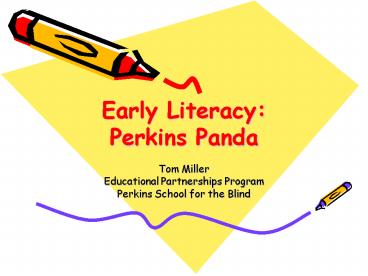Early Literacy: Perkins Panda - PowerPoint PPT Presentation
1 / 30
Title:
Early Literacy: Perkins Panda
Description:
Perkins Panda Resource Guide, p 6, 2002. Early Literacy. Language development Hierarchy ... The Perkins Panda Early Literacy Program is designed to encourage: ... – PowerPoint PPT presentation
Number of Views:454
Avg rating:3.0/5.0
Title: Early Literacy: Perkins Panda
1
Early LiteracyPerkins Panda
- Tom Miller
- Educational Partnerships Program
- Perkins School for the Blind
2
Early Literacy
- What is Literacy????
- Literacy in its most basic form is the ability
both to understand and to express ones feelings,
desires and experiences to others. - Perkins Panda Resource Guide, p. 7, 2002
3
Early Literacy
- How does literacy develop?
- Experiences are at the heart of literacy
development. - Perkins Panda Resource Guide, p 6, 2002
4
Early Literacy
- Language development Hierarchy
- Verbal Symbolic Behavior
- Visual Expressive language Writing
- Visual Receptive Language Reading
- Auditory Expressive Language Speech
- Auditory Receptive Language
- Comprehending the Spoken Word
- Inner Language
- Visual/Auditory Symbol and experience
- EXPERIENCE
- Myklebust, Psychology of Deafness, 1969
5
Early Literacy
- How might visual impairment and/or additional
disabilities affect literacy development? - Primary issue is the loss of incidental learning
ACCESS to the full sensory experiences of life
which enable us to build an understanding of the
world.
6
Early Literacy
- What is our role as parents, caregivers and
professionals in literacy development? - As families, caregivers and professionals our
primary role is enabling the child to read the
world. - Rosenketter, Learning to Read the World, p. 4,
2004
7
Early Literacy
- The Perkins Panda Early Literacy Program is
designed to encourage - Connections between caregiver and child
- Literacy opportunities which focus on play and
social interaction
8
(No Transcript)
9
(No Transcript)
10
Early Literacy
- To enable the child to read the world you need
- PRESENCE being there when child reaches for a
toy, smiles, and responding with acknowledgement,
pleasure, and verbal labels. - Music and songs create a fun opportunity for
being present with your child. - An opportunity for movement, concept development
and social interaction. - Rosenketter, Learning to Read the World, p. 6,
2004
11
(No Transcript)
12
Early Literacy
- TIME to notice and expand on the childs
efforts, to explain actions and words, and to
share, label and jointly experience everyday
activities. - Opportunities for literacy learning exist within
all our day to day experiences with our child. - Rosenketter, Learning to Read the World, p. 6,
2004
13
(No Transcript)
14
(No Transcript)
15
Early Literacy
- WORDS well chosen to encourage childs efforts,
words combined with waiting for the childs first
communication attempts via whole body movements,
gesturing, vocalizations or pseudo-words. - Rosenketter, Learning to Read the World, p. 6,
2004
16
Early Literacy
- Literacy is more than words.
- Literacy involves the ability to read and
communicate ones needs and desires through
objects, symbols, pictures, sign, gestures, or
print.
17
(No Transcript)
18
(No Transcript)
19
Early Literacy
- PRINT acknowledge and expose the child to the
many forms of print (symbols, pictures, Braille)
in their day to day life. - Rosenketter, Learning to Read the World, p. 6,
2004
20
(No Transcript)
21
Early Literacy
- Successful literacy development connects objects,
words, symbols, or pictures to the childs
experiences. - Literacy gives meaning to your childs world and
connects them to others.
22
(No Transcript)
23
(No Transcript)
24
Early Literacy
- INTENTION repeatedly and emphatically emphasize
the lifelong importance of (for both adult and
child) of words and print. - (tangible symbols objects pictures, Braille)
- Rosenketter, Learning to Read the World, p. 6,
2004
25
(No Transcript)
26
(No Transcript)
27
Early Literacy
- Key message is
- Language works. Print, objects, symbols,
braille are fun. They make my life better. - Rosenketter, Learning to Read the World, p. 6,
2004
28
(No Transcript)
29
(No Transcript)
30
Early Literacy
- Literacy development is grounded in our
interactions with the child with visual
impairments - and
- In how we make everyday experiences and concepts
accessible.































